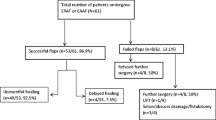Abstract
Background
In this study, we determined the long-term outcome of perianal fistulas treated with mucosal advancement flap (MF) or fistulotomy (FT).
Methods
One hundred three patients with perianal fistulas were treated by MF for high fistulas or FT for low fistulas and were retrospectively assessed by case-note review and examined at the out-patient clinic. The localization and time of recurrence of the fistula were recorded.
Results
Forty-one patients [median follow-up of 72 months (range 48–99)] were treated by an MF, and 62 patients [median follow up of 75 months (range 48–99)] were treated by FT. After 12, 48, and 72 months, the fistula had recurred in 9 (22%), 26 (63%), and 26 (63%) patients of the MF group and in 4 (7%), 16 (26%), and 24 (39%) patients of the FT group, respectively. Eighteen (69%) of the recurrences in the MF group and ten (33%) of the FT group occurred within 24 months after surgery (p=0.01). Four (15%) of the recurrences in the MF group and 13 (54%) of the recurrences in the FT group were present in a different localization (p=0.007).
Conclusion
The success rate of both FT and MF techniques decreases with time. Recurrence appears to be caused by failure of treatment and by recurrent patient disease.




Similar content being viewed by others
References
Reznick RK, Bailey HR (1988) Closure of the internal opening for treatment of complex fistula-in-ano. Dis Colon Rectum 31(2):116–118
Schouten WR, van Vroonhoven TJ (1991) Treatment of anorectal abscess with or without primary fistulectomy. Results of a prospective randomized trial. Dis Colon Rectum 34(1):60–63
Ortiz H, Marzo J (2000) Endorectal flap advancement repair and fistulectomy for high trans-sphincteric and suprasphincteric fistulas. Br J Surg 87(12):1680–1683
Abel ME et al (1993) Autologous fibrin glue in the treatment of rectovaginal and complex fistulas. Dis Colon Rectum 36(5):447–449
Hamalainen KP, Sainio AP (1997) Cutting seton for anal fistulas: high risk of minor control defects. Dis Colon Rectum 40(12):1443–1446; discussion 1447
Hyman N (1999) Endoanal advancement flap repair for complex anorectal fistulas. Am J Surg 178(4):337–340
Zmora O et al (2003) Fibrin glue sealing in the treatment of perineal fistulas. Dis Colon Rectum 46(5):584–589
Zimmerman DD et al (2001) Anocutaneous advancement flap repair of transsphincteric fistulas. Dis Colon Rectum 44(10):1474–1480
Barwood N et al (1997) Fistula-in-ano: a prospective study of 107 patients. Aust N Z Surg 67(2–3):98–102
Sonoda T et al (2002) Outcomes of primary repair of anorectal and rectovaginal fistulas using the endorectal advancement flap. Dis Colon Rectum 45(12):1622–1628
Theerapol A, So BY, Ngoi SS (2002) Routine use of setons for the treatment of anal fistulae. Singapore Med J 43(6):305–307
Williams JG et al (1991) Seton treatment of high anal fistulae. Br J Surg 78(10):1159–1161
Miller GV, Finan PJ (1998) Flap advancement and core fistulectomy for complex rectal fistula. Br J Surg 85(1):108–110
Schouten WR, Zimmerman DD, Briel JW (1999) Transanal advancement flap repair of transsphincteric fistulas. Dis Colon Rectum 42(11):1419–1422; discussion 1422–1423
Van Tets WF, Kuijpers JH (1995) Seton treatment of perianal fistula with high anal or rectal opening. Br J Surg 82(7):895–897
Athanasiadis S et al (1996) Endo-anal and transperineal continence preserving closure techniques in surgical treatment of Crohn fistulas. A prospective long-term study of 186 patients. Chirurg 67(1):59–71
Balogh G (1999) Tube loop (seton) drainage treatment of recurrent extrasphincteric perianal fistulae. Am J Surg 177(2):147–149
Amin SN et al (2003) V-Y advancement flap for treatment of fistula-in-ano. Dis Colon Rectum 46(4):540–543
Seow C, Phillips RK (1991) Insights gained from the management of problematical anal fistulae at St. Mark’s Hospital, 1984–88. Br J Surg 78(5):539–541
Garcia-Aguilar J et al (1996) Anal fistula surgery. Factors associated with recurrence and incontinence. Dis Colon Rectum 39(7):723–729
Buchanan GN et al (2004) Long-term outcome following loose-seton technique for external sphincter preservation in complex anal fistula. Br J Surg 91(4):476–480
McKee RF, Keenan RA (1996) Perianal Crohn’s disease—is it all bad news? Dis Colon Rectum 39(2):136–142
Cuenod CA et al (2003) MR imaging of ano-perineal suppurations. J Radiol 84(4 Pt 2):516–528
deSouza NM et al (1998) MRI of fistula-in-ano: a comparison of endoanal coil with external phased array coil techniques. J Comput Assist Tomogr 22(3):357–363
Maccioni F et al (2002) Value of MRI performed with phased-array coil in the diagnosis and pre-operative classification of perianal and anal fistulas. Radiol Med (Torino) 104(1–2):58–67
Beets-Tan RG et al (2001) Preoperative MR imaging of anal fistulas: does it really help the surgeon? Radiology 218(1):75–84
Beets-Tan RG et al (1999) High-resolution magnetic resonance imaging of the anorectal region without an endocoil. Abdom Imaging 24(6):576–581; discussion 582–584
Van Assche G et al (2003) Magnetic resonance imaging of the effects of infliximab on perianal fistulizing Crohn’s disease. Am J Gastroenterol 98(2):332–339
Buchanan G et al (2002) Effect of MRI on clinical outcome of recurrent fistula-in-ano. Lancet 360(9346):1661–1662
D’Agostino G et al (2000) Treatment of complex anal and rectovaginal fistulas using the endorectal mucosal flap technique. Minerva Chir 55(6):465–469
Durgun V et al (2002) Partial fistulotomy and modified cutting seton procedure in the treatment of high extrasphincteric perianal fistulae. Dig Surg 19(1):56–58
Malouf AJ et al (2002) A prospective audit of fistula-in-ano at St. Mark’s hospital. Colorectal Dis 4(1):13–19
Author information
Authors and Affiliations
Corresponding author
Rights and permissions
About this article
Cite this article
van der Hagen, S.J., Baeten, C.G., Soeters, P.B. et al. Long-term outcome following mucosal advancement flap for high perianal fistulas and fistulotomy for low perianal fistulas. Int J Colorectal Dis 21, 784–790 (2006). https://doi.org/10.1007/s00384-005-0072-7
Accepted:
Published:
Issue Date:
DOI: https://doi.org/10.1007/s00384-005-0072-7




